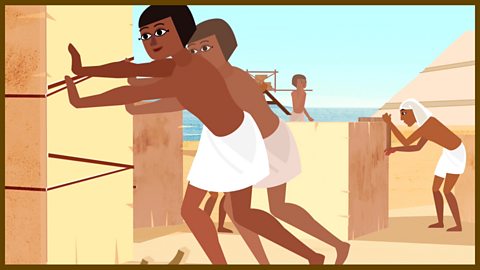Rames is 12 years old and about to join the many thousands of workers constructing one of the pyramids.
Ramy: Hi, I'm Rames. Everyone calls me Ramy. And that over there is my brother User. His name means 'strong'. You can see why he got it.
I'm stronger than I look though. That's why I'm going with User and the others to help with the pharaoh's big project.
User has been able to go for a few flood seasons now.
But this is the first time I've been old enough to go.
The pharaoh's project is the biggest thing that's ever been built in Egypt and that's why they need all the strong workers, from farms across the Nile Valley, to come and help during Ahket, the flooding season.
That's when the land is too wet for farmers to work on.
I can't wait to see it.
Wow!
Look at that.
What's that?
Foreman: Move it boy, you're here to work, not daydream!
Ramy: This is my first morning on site and there's so much to see. The stone used to build these pyramids is cut directly out the ground, right here on site. So, it doesn't have to move far. Clever, right?
Foreman: Heave!
Ramy: It's so heavy and it moves so slowly. I'm used to hard work on the farm but this is something else.
The problem is that those blades are pushing the sand forward. As we're moving the sled, so the further forward we move the moresand that gathers up.
And the harder it is to pull (panting). It's so difficult!
Foreman: Get that boy up. Who brought him here?
Ramy: Will it work?
Foreman: What are you doing? Stop it boy! We need that water.
Ramy: Pull now, look it will work! The wet sand is harder than the soft sand. The sled will side more easily and it won't pull the sand with it.
Look, try it!
Please. Trust me.
Foreman: OK, we'll try it.
Ramy: Please make it work.
Foreman: Everyone in position andÔÇŽheave, heave! Bring more water. OK, boy, show us what to do.
Ramy: You see when the sand is wet the tiny spaces in between the grains are filled with water. This makes the sand feel firmer and the sled can move more easily across it.
Now that was a hard day's work!
Foreman: Well done boy, this idea of yours will make things a lot easier. What's your name?
Ramy: Ramy, I mean Rames, sir.
Foreman: Well, Rames, you really helped us out today. Tomorrow we'll bring water directly from the Nile. You can oversee it. I think that might be better suited to your talents than this heavy lifting. Don't you?
Ramy: Thank you, sir. You see it's not only bulging muscles make you strong. I told you I was stronger than I look!
Rames - The Engineer
Video summary
This video follows the story of Ramy, a 12 year old boy from the Old Kingdom of Ancient Egypt.
As it is Ahket - the flooding season - Ramy and his brother User are not able to work the land. So they are travelling along the River Nile with a group of young workers to the construction site of a new pyramid.
We follow Ramy as he explores the construction site for the first time and are introduced to a set square and plumb line, which is an important tool used by the Ancient Egyptians to make the pyramids level.
We learn about the challenges of moving vast masses of material without the tools and automated machines that we have today.
This is where RamyÔÇÖs creative thinking comes in. He works out that the sleds used to move large stone blocks into position work more effectively if the sand is wet.
This makes the building of the pyramids easier and quicker - and Ramy proves that there is more to strength than just muscles.
Teacher's Notes
This resource provides an opportunity to develop a deeper understanding of how the Ancient Egyptians used science and engineering to build the pyramids. Pupils can carry out a practical investigation to find out the difference adding water to sand makes to the force needed to pull an object.
As the video progresses, opportunities arise for teachers to discuss skills and talents with pupils and to highlight that in diversity of skills we have strength. Linking to the PSHE curricula by helping pupils understand the importance of various skills when looking at the make-up of a team.
There are opportunities to explore life through the seasons in Ancient Egyptian times, looking at how and why people were able to be released from farming duties to support the building of the pyramids.
Points for discussion (History Linked)
- How would you feel approaching the site and seeing the pyramid for the first time?
- Can you explain why RamyÔÇÖs idea of adding water to the sand worked?
- What do you think it would have been like to work on a pyramid construction?
- What do you think a set square and plumb line were used for?
- What were the pyramids used for?
- Why were the young people taken from the farms to the pyramid construction sites at this time of year? Why were they not needed on the farm?
Suggested Activities (Cross Curricular opportunities)
Force Investigation ÔÇô Using sand, water, and a standard mass (1kg etc), pupils can replicate the use of water on sand to make moving items easier. Using a force-meter, pupils to pull the weight along the sand and record the force needed. Repeat this, adding water to the sand and recording any changes in force required. Pupils can develop a conclusion to outline how correct RamyÔÇÖs idea was.
Creative Writing ÔÇô After his discovery, write a diary entry as if pupils were Ramy. How did they feel when they arrived at the site? What did they discover? How did they feel? Opportunity to continue this and write about subsequent days as Ramy assumed the role of supervisor.
Roles of a TeamÔÇô Discussion: ÔÇśWhat did Ramy bring to the team?ÔÇÖ As the discussion progresses, explore whether Ramy would have felt useful during the entire film, or did his feelings of self-worth change as the video went on? Opportunity for a circle time discussion around what we like and admire about others, focussing on the things that are inside rather than physical things.
Building a Pyramid ÔÇô Using smaller cubes such as sugar cubes, can the pupils build their own pyramid. As they do this, they can explore the challenges of achieving the correct shape and size as well as thinking about the tools the Ancient Egyptians would have needed for their pyramids to be built successfully.
Impacts of flooding ÔÇô Young people were available to help with building pyramids during Ahket because they were unable to farm due to the River Nile flooding. Can pupils find out what causes flooding and how humans respond to it? What are the positive and negative impacts of living in a flood zone and how have humans reacted over time to these?
This film is relevant for teaching History at KS2 in England, Wales and Northern Ireland and 2nd Level in Scotland.
King Tutankhamun. video
Exploring the life and death of King Tutankhamun and the excavation of his tomb in 1922.
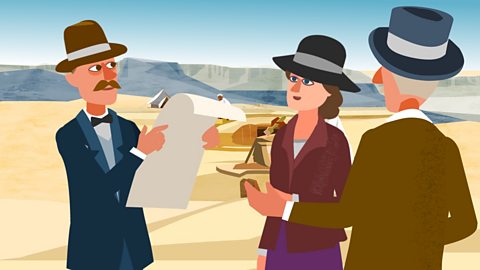
Nanu - The Farm Girl. video
Nanu is 12 years old and works at home on the farm - but she longs to train as a doctor.
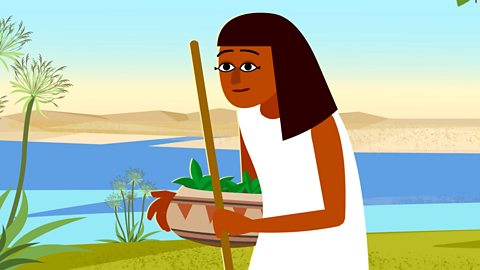
Hussein - The Water Boy. video
Hussein is a young water carrier working at the excavation of King Tutankhamun's tomb in 1922.
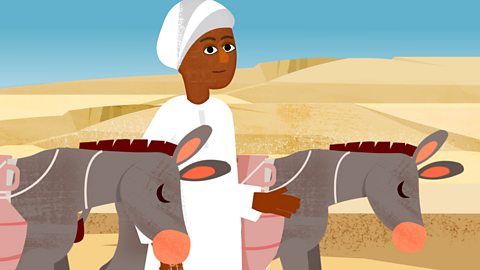
See also...
KS2 Music: Ancient Egypt. collection
A collection of fun, catchy songs and activities to help you consolidate your study of Ancient Egypt.
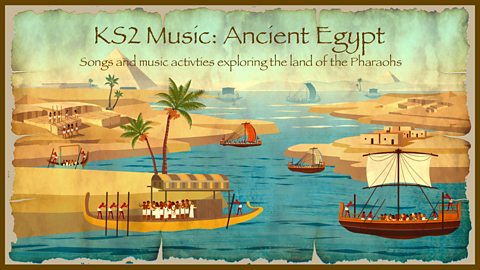
Song: 'Build that pyramid'
Join in with a lively work song about the building of the pyramids in Ancient Egypt.
